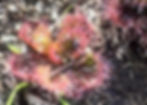In the world of bees, something very cool happened recently - and it created quite a buzz in the media worldwide!
A brand-new native bee species was discovered by Dr Kit Prendergast from the Curtin School of Molecular and Life Sciences. If you haven't come across Dr Kit before, she’s an extraordinary bee educator, researcher, and all-round science communicator. And just in case I haven’t told you this already: Australia is home to over 2,000 species of native bees.
Yes - two thousand! No - they’re not all yellow, black, stripy, and obsessed with making honey
Our native bees come in all the colours of the rainbow - blues, greens, reds, metallic sheens - tiny ones the size of a grain of rice, and chunky ones that sound like tiny motorbikes. They’ve co-evolved with our native plants, meaning each species has its own ecological story. To protect them, we need research, curiosity… and discoveries like Dr Kit’s.

A Bee Named… Lucifer?!
Here’s where it gets even cooler....
The newly discovered bee is named Megachile (Hackeriapis) lucifer.
No, it’s not evil - just fabulously named.
The name was inspired by the female bee’s unusual upward-facing, convex, horn-like structures on her face. She also happens to be the pollinator of a critically endangered plant called Bremer marianthus (Marianthus aquilonaris), making her discovery even more important.
And here’s a fun fact: Whoever formally describes a new species in a scientific journal gets to choose its name.
Yep - naming rights! But don’t worry, it’s not a free-for-all. There are rules. (More on that in a sec.)
Why We Name Species at All: The Human Need for Order
Humans absolutely love organising things. From Tupperware to paint brushes to socks and undies… and yes, all the living organisms on Earth.
When scientists classify living things, they’re not just being fussy. Classification helps us:
understand relationships between species
predict things like growth habits, behaviour, pests, and diseases
compare new discoveries to what we already know
protect ecosystems by recognising what depends on what
Taxonomy - the science of naming and classifying life - is basically the world’s biggest library system, but for everything from whales to wasps to weird underground fungi.
Why Latin? A Universal Language for Nature
Across the globe, thousands of languages exist and billions of people interact with nature every day. That’s a lot of ways to say “bee.”
Common names are helpful, but they’re not consistent. One species might have six or seven different names depending on the region - or the language. A great example is the Australian White Ibis - colloquially known as the "bin chicken" for it’s tendency to raid rubbish bins in urban environments.
Latin solves that problem.
Nobody speaks Latin as their first language anymore, which means:
meanings don’t drift over time
scientists can use the same name anywhere in the world
the system stays stable for centuries
If you say Megachile (Hackeriapis) lucifer, a scientist in Sweden, Mexico, or Japan knows exactly which bee you mean.
Taxonomy 101: The System Behind the Names
The naming system we still use today began in the mid-1700s with Carl Linnaeus, a Swedish botanist.
He formalised:
1. Binomial Nomenclature
Every species has two names: Genus + species, like Homo sapiens or Apis mellifera.
The name of the genus is always Capitalized and italicised.
2. The Hierarchical System
From broadest group to smallest:
Kingdom → Phylum → Class → Order → Family → Genus → Species
To remember this, use the chant: “King Philip Came Over For Good Soup.”
The Weird, the Witty, and the Wonderful: Strange Scientific Names
Taxonomists have a sense of humour - often a very good one!
Here are some quirky scientific names given to newly discovered species:
A beetle with bulging, muscular back legs. Named after Arnold Schwarzenegger. Obviously.
A bright orange lichen from California, named after Barack Obama.
A square, spongy mushroom named after… yes, SpongeBob SquarePants.
A millipede named after Taylor Swift for bringing “joy” to the scientist who described it.
An orchid bee named after Sheldon Cooper’s catchphrase from The Big Bang Theory: “Bazinga!”
Biodiversity meets pop culture - it’s pretty cool!
The Magic of Not Knowing (Yet)
Taxonomy might sound daunting at first glance, but it’s actually a wonderful, ongoing story about how diverse and colourful our world is. And the most exciting part?
There are still so many species left to discover.
Every year, researchers and citizen scientists uncover new plants, fungi, insects, and marine creatures - some hiding in plain sight, others tucked away in remote pockets of the world.
And sometimes, like Megachile (Hackeriapis) lucifer, they are found by passionate scientists like Dr Kit Prendergast, working to protect the ecosystems we depend on.
Who knows what incredible bee or beetle or fungi - you’ll hear about next?
Want to Learn More About Biodiversity & Citizen Science? Incursions & Workshops
If you love this kind of stuff as much as I do, I run workshops and incursions all about:
Bees
Biodiversity
Pollination
Citizen Science
Whether you're a school, community group, or curious nature lover - come and explore the unexpected stories of the natural world with me.




.png)






